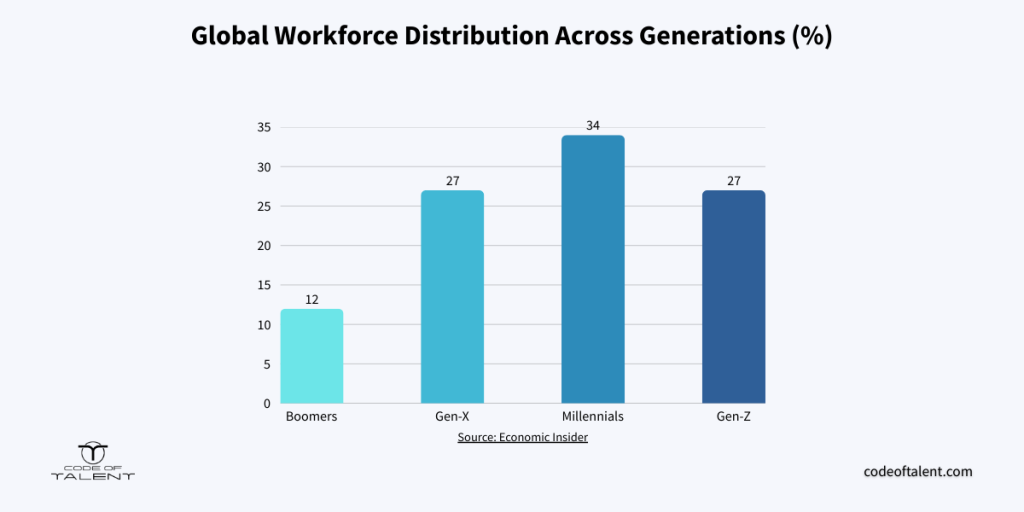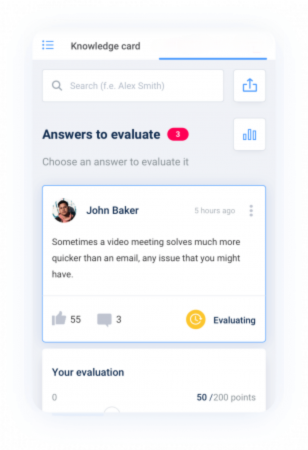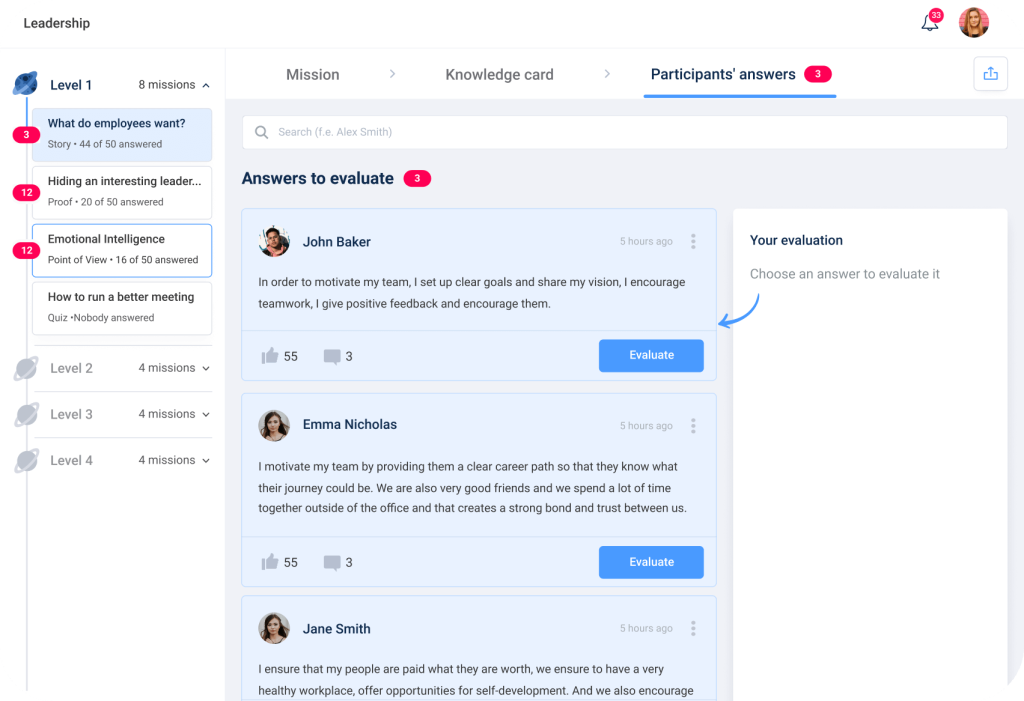In March 2025, around 3.3 million Americans quit their jobs, demonstrating that high turnover is now the norm, even during times of uncertainty. While there’s no single cause, or solution, for this trend, one factor that companies often overlook is how well they’re training a multigenerational workforce.

It’s not about fixing turnover with training, but about recognizing that different generations have different needs that training can address, and those needs deserve more attention than they’re currently getting.
This article explores the key challenges of training a multigenerational workforce, explains why it’s important to tailor learning to different age groups, and offers practical tips for doing it effectively.
The Importance of Training a Multigenerational Workforce
Today’s workforce is made up of four distinct generations, each with its own experiences, preferences, and expectations. According to the Economic Insider, here’s how the global workforce breaks down:
- Boomers (1946–1964): ~ 12%
- Gen X (1965–1980): ~27%
- Millennials (1981–1996): ~34%
- Gen Z (1997–2012): ~27%

Each generation grew up with different technologies, work expectations, and definitions of success. They also have biases from their professional backgrounds, academic experiences, and social environments. So it’s no surprise that they learn differently, too.
Yet most training programs treat everyone the same. Ignoring these differences leads to disengagement, costly mistakes, and ultimately turnover.
When People Don’t Learn, They Leave
Younger workers, in particular, are walking out the door when they feel they’re not learning. In fact, according to a recent survey, 74% of Millennials and Gen Z employees have considered quitting because they weren’t getting enough opportunities to develop new skills.
These workers expect continuous growth, and if they don’t get it, they won’t hesitate to look elsewhere. Meanwhile, this fuels the ongoing trend of job-hopping across industries. While older generations often blame younger ones for job-hopping, the truth is, every generation has done it. Gen X and Boomers job-hopped when they were the same age too.
Training a Multigenerational Workforce the Right Way
Each generation has different comfort levels with technology, communication styles, and expectations. Here’s how to meet them where they are.
Boomers (1946–1964)
Description: Many Boomers are still active in the workforce and bring decades of experience. Yet despite their contributions, they’re often the target of age-related stereotypes. A study in the Computer and Information Science Journal highlights that Boomers, though experienced and loyal, frequently face assumptions about declining performance and adaptability. Harvard Business Review also notes that older workers are regularly seen as slow or resistant to technology, even though many are eager to learn and evolve.
Training benefits: It’s true that some Boomers feel overwhelmed by rapid advancements, especially with AI and the growing number of digital tools. But many are willing and able to adapt. Training then needs to meet both ends of the spectrum: those who are ready to learn and those who may need more support.
For older generations, targeted learning can bridge widening skills gaps in tech, tools, and processes. When people feel they’re falling behind, their confidence often drops, leading to frustration and disengagement.
Learning preference:
- Face-to-face interactions
- Structured environments
- Practical exercises, especially with learning tech
Training tips:
- Offer hybrid formats that combine in-person and digital learning
- Use simple interfaces with guided support
- Include live sessions or mentoring options where they can learn from colleagues in real time
- Offer technical skills training to understand how latest tech tools work

Gen X (1965 – 1980)
Description: Often referred to as the “forgotten generation,” Gen Xers hold a significant portion of today’s mid-to-senior leadership roles. They grew up during the rise of personal computing and were the first to transition from analog to digital. As a result, they’re often adaptable and self-reliant, but they’re also frequently overlooked in conversations about professional development.
Training benefits: Gen Xers are proactive about their professional development. The Kelly Global Workforce Index found that 74% of Gen X employees are willing to invest their own money to upgrade their skills, surpassing both Gen Y and Boomers in this regard. However, despite their willingness, many feel unsupported by their employers.
Learning preference:
- Learning they can do on their own, at their own pace
- Clear objectives
- Measurable outcomes
- Practical, real-world applications
- Interactive and collaborative environments
- Immediate feedback mechanisms
Training tips:
- Offer easy-to-access lessons that people can start anytime and work through on their own
- Incorporate real-life scenarios and case studies
- Mix online tools with in-person or live sessions
- Create spaces where coworkers can share tips and learn from each other
- Keep the training focused and to the point
- Offer leadership development training for workers with decision-making power

Millennials (1981 – 1996)
Description: Millennials now make up a significant portion of the workforce. Having grown up during the rise of the internet and social media, they are tech-savvy and value flexibility, purpose, and continuous learning in their careers. According to a Gallup study cited by Turf Magazine, 60% of Millennials consider the opportunity to learn and grow on the job as extremely important.
Training benefits: Millennials are eager to improve their skills and seek employers who invest in their professional development. A survey by ManpowerGroup found that 93% of millennials want lifelong learning opportunities, and 80% consider the opportunity to learn new skills a key factor when choosing a job.
Learning preferences:
- Short learning modules they can access anytime
- Interactive and hands-on experiences
- Opportunities for collaboration and social learning
- Immediate feedback and recognition
- Training that aligns with their personal and professional goals
Training tips:
- Develop microlearning content that can be consumed in short periods, such as during a commute or break
- Incorporate real-life scenarios and practical exercises (such as simulations) to make learning more applicable
- Facilitate group discussions and peer-to-peer learning
- Offer mentorship programs
- Provide regular feedback and celebrate achievements
- Use relevant training KPIs to align learning initiatives with their goals

Gen Z (1997 – 2012)
Description: Gen Z is the newest generation entering the workforce. They’ve grown up with smartphones, Wi-Fi, and social media at their fingertips. While they’re incredibly comfortable with technology, many of them began their careers during the COVID-19 pandemic, meaning remote work and digital communication shaped their early professional experiences.
This shift has impacted how they interact with colleagues. According to the New York Post, 74% of employees struggle with face-to-face communication, and Gen Z makes up 40% of that group.
Training benefits: Gen Z wants to succeed, but many haven’t had much experience in traditional workplace environments. They’re still figuring out how to navigate office culture, in-person collaboration, and professional communication. That’s where training can make a difference: helping them work on their confidence, understand expectations, and learn how to work with people of different ages and backgrounds.
Learning preferences:
- Fast, digital-first learning that’s mobile-friendly
- Visual content: videos, interactive graphics, and games
- Social learning where they can interact and share
- Customized paths that match their interests and roles
Training tips:
- Provide a wide range of training formats such as videos, interactive presentations, quizzes, surveys, and sharing ideas
- Integrate Gen-Z workers into the company culture with strategic onboarding
- Use gamification (which includes features such as leaderboards, medals, and badges) to make learning feel more interactive and fun
- Help them build soft skills, like teamwork, time management, and in-person communication
- Offer collaborative learning opportunities where they can ask questions and learn from others
- Give frequent feedback
Conclusion
Training a multigenerational workforce has a direct impact on how long they stay, how well they perform, and how connected they feel to the company. When we treat training as a one-size-fits-all task, we lose more than just time, but also talent.
Each generation brings something different to the table. When building a strategy that understands those differences, everyone wins. That means thinking beyond traditional methods. It means adapting to digital learners, supporting those who prefer hands-on experiences, and closing the gaps caused by technology and time.
Platforms like Code of Talent make this not just possible but also easy. With tools that are built for the way people actually learn today, companies can build a workplace where everyone grows together.
Code of Talent offers:
- Microlearning: Short, bite-sized content that fits busy schedules and short attention spans
- Mobile-first access: Ideal for Millennials and Gen Z who expect to learn on the go
- Gamified and social features: Keeps younger workers engaged while also encouraging interaction across teams
- AI-driven adaptation: Learners get content based on their role and experience
- Behavioral insights: Managers, mentors, and training facilitators can track progress, adjust content, and support real transformation.
Training a multigenerational workforce means meeting people where they are and giving them the tools to grow together, not apart. If you’re ready to see how that can look in practice, start your free trial of Code of Talent and take the first step toward smarter, more inclusive learning!
Cover photo: Freepik





